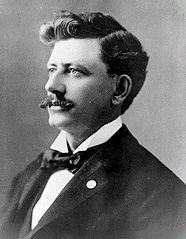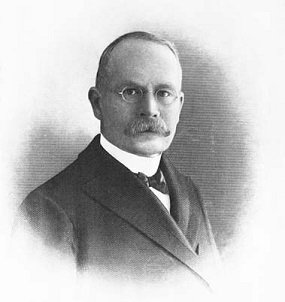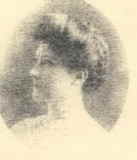John Osborne, doctor and politician
 John Eugene Osborne, future governor of Wyoming, was born in the state of New York in 1858. His parents were both immigrants – his father came from England, while his mother was Canadian. The family lived in the town of Westport which mostly served as a tourist destination at that time. In 1874 they moved to Burlington, Vermont, where the teenage John got a job working in a local drugstore. He studied medicine, and qualified from the University of Vermont at the age of 20. With his new diploma in hand he went to work for Union Pacific, where he became the assistant to Doctor Thomas Maghee.
John Eugene Osborne, future governor of Wyoming, was born in the state of New York in 1858. His parents were both immigrants – his father came from England, while his mother was Canadian. The family lived in the town of Westport which mostly served as a tourist destination at that time. In 1874 they moved to Burlington, Vermont, where the teenage John got a job working in a local drugstore. He studied medicine, and qualified from the University of Vermont at the age of 20. With his new diploma in hand he went to work for Union Pacific, where he became the assistant to Doctor Thomas Maghee.

Maghee was a civil war veteran who had taken up medicine after he was invalided out of the army, and then rejoined as an army surgeon. This had sent him from fort to fort, as the military action against the Native American tribes continued throughout the 1870s. In 1878, the same year that John graduated, he resigned from the army and set up in private practice. In 1880 he moved to the town of Rawlins, capital of Carbon County in Wyoming, where he signed on with Union Pacific to act as their surgeon. John Osborne was his assistant, and the practice nurse was a 15 year old girl named Lillian Heath. Lillian was no blushing violet though – she wore men’s clothes and carried a revolver, a sensible precaution in Rawlins. It was a rough and lawless town, yet something in it seemed to speak to people. All three of them set down roots there that would last for the rest of their lives. Lillian got the job through her father, who sometimes assisted Doctor Maghee. A shared interest in science was probably what drew those two men together, as her father was an inventor who had known Edison before the family moved west and one of Maghee’s most notable traits was a healthy streak of scientific curiosity. This may be why he commandeered the body of George Parrott.

Parrott was an outlaw who ran with a gang. He may have been the leader of the gang, though he later claimed it was led by a mysterious man named Sim Jan. In 1878 the gang decided to rob a Union Pacific train near Medicine Bow in Carbon County, about fifty miles from Rawlins. Their plan was to derail a train and loot the wreckage, but it was foiled when a foreman, returning to retrieve some forgotten tools, spotted the sabotage. He alerted the authorities, who went out to examine the site and found hoof prints. Two deputies tracked the trail back to the outlaws’ hideout, but were shot and killed. Realising that this would bring more heat than they could handle the gang split up and went their separate ways. Sim Jan (an alias, of course) was never identified. Some speculate he may have been Jesse James, but there is no evidence for this. Several members of the gang were captured but Parrott escaped the net – until he got drunk in a bar in Miles City two years later, and boasted about the time he got away with murder. His words were reported and led to his arrest. As the crime had taken place in Carbon County, he was returned to Rawlins to stand trial. In April of 1881 he was sentenced to death. While his attorneys readied an appeal Parrott took matters into his own hands and attempted an escape, only to be foiled by a pistol-wielding jailer’s wife. When word of this spread, the locals decided to take the law into their own hands. The two dead deputies had been popular men, and they had no wish to see the killer get away. Masked men stormed the jail, took Parrott from his cell, and lynched him in such a crude manner that one of his ears was torn off. As there were no known relatives to come forward, his body was unclaimed, so Maghee requested it for scientific study – a practice of dubious legality at the time, but he was able to persuade the authorities to comply. And here is where the story takes a turn for the bizarre.
At the time the study of neurology was in its infancy, but Doctor Maghee was a man who kept himself well appraised of current developments. Thirty years earlier Phineas Gage, a railway worker, had survived severe brain damage when a rod had been driven through his head. The changes in his personality evident after the damage had led to a great deal of discussion and speculation as to what damage in the brain could result in criminal behaviour. Maghee hoped to find some damage or deformity in Parrott’s brain, so they sawed the top of his skull off and extracted the brain. Disappointingly it proved to be perfectly normal in appearance. The top of the skull was presented to Lillian as a souvenir of her first autopsy, and her husband would later use it as an ashtray. This was not the most macabre memento of the event, though. After they had taken a death mask of Parrott’s features, they removed the skin from his chest and thighs and sent it off to a tanner in Denver, who used it to make a pair of shoes and a doctor’s bag. What happened to the bag is unknown, but John kept the shoes. He’s reported to have been disappointed that they hadn’t been able to make Parrott’s nipples into the toes. The rest of the body was kept in an old whisky barrel filled with salt water for a while, but eventually it was buried without ceremony in the back yard of the cemetery. We know this because it was rediscovered in 1950 by construction workers. Lillian’s old ashtray was shown to perfectly fit the damaged skull, and the various pieces (except the missing doctor’s bag) ended up on display in the local museum.

In the years following this odd incident, John went from strength to strength. He had opened a drugstore in Rawlins, as well as taking up sheep farming on the side. Both ventures proved extremely successful. He would go on to co-found the Rawlins State Bank, which became the Rawlins National Bank and remains in business to this day. In 1883 he entered politics, spending a brief term in the State Assembly before becoming mayor of Rawlins in 1888. In 1892 he attended the Democratic National Convention and then stood for election as governor of Wyoming on their ticket. Wyoming was generally a Republican state at the time, but the Johnson County War [1] that year had shaken people’s faith in the current administration. Still, the election was a close run thing. John was leading the count on December 2, but returns from two counties were being delayed. The current governor had never been elected, but was the former State Secretary (effectively Deputy Governor) acting as governor after the state’s first governor resigned to take up a seat in the senate two years before. He had been delaying elections ever since, and John saw this as yet another stalling move. Tiring of the delay, John took the oath of office before a notary public, then broke into the governor’s office (either through sneaking along a window ledge, or by hiring a young boy to do it for him). Once there, he refused to leave and wound up in a fight with the previous governor’s secretary over the key to the office. In the end the returns from the two counties showed up, and John was declared Governor officially on the 2nd January, 1893. At his inaugural ball, he wore his human-skin shoes.
John was only governor for two years, finding that running a still largely Republican state as a Democrat was a thankless task. During his time in office he saw his old friend Lillian Heath become Wyoming’s first woman doctor and set up shop in Rawlins. She and Maghee had become famous several years earlier for reconstructing a man’s destroyed nose using skin and bone grafts, a groundbreaking procedure that Maghee wrote up and published in a national medical journal. After John’s term ended he once again attended the Democratic National Convention, and in 1897 he was elected as a Congressman for Wyoming. As with the governership he only served a single term. In 1900 he joined the Democratic National Committee, the organising body for the national party, and remained a member for the next 20 years.

In 1907 John went on a cruise with a group of fellow MDs, travelling around the world. In Rome he met John and Nancy Smith, a rich couple from Princeton, Kentucky. They and their family were on a Mediterranean tour. John was immediately smitten with their youngest daughter, Selina. The feeling was mutual, and he abandoned his own cruise to join the Smiths on theirs. While Selina’s parents were less than thrilled that their 24 year old daughter was being courted by a man literally twice her age, they eventually relented after the end of the tour, when John made several trips to Kentucky to see her. The two were married in the summer of 1907, though there is no report of what shoes John wore to the wedding. The following year they had their only child, a daughter named Jean. The house that the Smith family lived in eventually became a museum, modelled around the time John and Nancy Smith lived there with their children, and it holds an annual event throughout the month of June to commemorate John and Selina’s wedding.

In 1913 John was appointed as Assistant Secretary of State by President Woodrow Wilson, a position he held through the President’s first term in office. In 1918 he ran for election as Senator from Wyoming, attempting to unseat his fellow former governor Francis Warren. He lost the election, however, and two years later he left the Democratic National Committee and retired to Rawlins. There he occupied himself with his businesses and enjoyed the quiet life of the town, which was far more sedate than it had been thirty years earlier. In 1942 Selina died, and the following year John joined her. His obituary mentioned the shoes he had made from Parrott, proving that even seven years before the bones resurfaced Wyoming still remembered the more peculiar side of one of its most illustrious citizens.
Images via wikimedia except where stated.
[1] A dispute between the Wyoming Stock Growers Association, formed of the largest landowners in the state, and the Northern Wyoming Farmers and Stock Growers Association, formed by a group of smaller farmers in an attempt to hold independent cattle drives. When the NWFSGA refused the WSGA’s order to disband, the richer farmers hired men to kill Nate Champion, NWFSGA president. He survived, but the WSGA soon began framing members of the NWSFGA as cattle rustlers. (In some cases, this may have been an accurate enough accusation.) Eventually a group of WSGA vigilantes laid siege to Champion’s farm and murdered him. Though the WSGA were too highly connected to ever face justice for the killing, the political fallout tainted all their associates for years.
